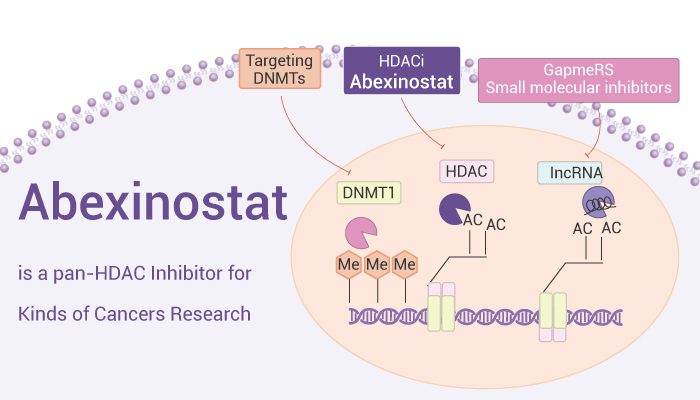Chromatin structure is affected by posttranslational core-histone modifications, including acetylation and deacetylation. HDACs (Histone deacetylases) are a class of enzymes that remove acetyl groups (O=C-CH3) from an ε-N-acetyl lysine amino acid on ahistone. HDACs allow the histones to wrap the DNA more tightly. This is important because DNA is wrapped around histones, and DNA expression is regulated by acetylation and de-acetylation. There are 11 known isoforms of the classic HDAC family, denoted HDAC1 to HDAC11. In addition to histones, HDAC enzymes are known to deacetylate other proteins, including α-tubulin, suggesting complex, multifunctional roles for HDACs in vivo. Deregulation due to increased HDAC expression or function occurs in many malignancies, resulting in abnormal modulation of target gene transcriptional activity. Thus, the development of HDAC inhibitors (HDACi) as anticancer therapies is crucial.

Abexinostat (also known as CRA 024781 or PCI-24781) is a broad spectrum HDAC inhibitor with antitumor activities in vitro and in vivo.
In addition, Abexinostat inhibits pure recombinant HDAC1, and also inhibits the other HDAC isozymes HDAC2, HDAC3/SMRT, HDAC6, HDAC8, and HDAC10 in the nanomolar range. Moreover, Abexinostat causes the accumulation of acetylated histone and acetylated tubulin, thereby inhibiting tumor cell growth and inducing apoptosis. Furthermore, Abexinostat exhibits significant cell proliferative activity in soft tissue sarcoma cells. Also induces S phase depletion, G2/M cell cycle arrest, and increases apoptosis. Besides, Abexinostat significantly reduces the tumor growth in mice harboring HCT116 or DLD-1 colon tumor xenografts. Meanwhile, inhibition of tumor growth is accompanied by an increase in the acetylation of α-tubulin in peripheral blood mononuclear cells.
In summary, Abexinostat is a pan-HDAC inhibitor with potently antitumor activities.
References:
[1] Joseph J Buggy, et al. Mol Cancer Ther. 2006 May;5(5):1309-17.
[2] Gonzalo Lopez, et al. Clin Cancer Res. 2009 May 15;15(10):3472-83.